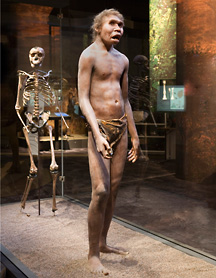- Latest Archaeology Updates
- Importance and applicability
- Famous Archaeologists
- Museums Collections
- Site Map
- World Heritage Sites
- World History Monuments
- Archaeological Organizations
- World Atlas of Archaeology
- Forensic Investigation and Geophysics
- Contact Us
- Movies based on Archaeology
- Frequently Asked Questions
- Archaeological discoveries
- Tell a Friend
- Archaeological Abbreviations
- Gallery Collections
- Famous-Museums site map
- Famous-archaeologists site map
- Archaeological Monuments site map
Turkana Boy also known as Nariokotome Boy, is the name given to the fossilized remains of a Homo erectus child found in 1984 at Nariokotome near Lake Turkana in Kenya. The remains are believed to be of a hominin who died at the age of eight to twelve years old, and is estimated to have lived 1.5 million years ago. This makes the Turkana Boy the oldest and most complete early human skeleton ever found.
The Turkana Boy was found in a shallow grave located near the shores of Lake Turkana. The remains were incomplete, with only about 40 percent of the skeleton found. The most complete parts of the skeleton include the skull, arms, legs, and some vertebrae. The skull is the most complete example of an early human's skull ever found. It shows that Homo erectus was the first human species to have a large brain case and small teeth.
The Turkana Boy's skeleton has provided scientists with valuable insight into the evolution of the human species. It has also allowed researchers to learn more about the physical changes that Homo erectus underwent over time. The skull of the Turkana Boy provides evidence of a large brain case and small teeth, which indicates that Homo erectus was the first species of human to have a large brain. Additionally, the skeleton of the Turkana Boy provides evidence of a more modern human body type. The Turkana Boy is estimated to have been about five feet tall, which is significantly taller than other Homo erectus.

- Archaeology plays an important role in uncovering the history of the Turkana people. Archaeological evidence and research have uncovered a wealth of information about the history, culture and lifestyle of the Turkana people.
- Archaeological investigations have revealed that the Turkana people have a long and complex history, with evidence of settlement in the region dating back to at least the Middle Stone Age.
- Archaeological evidence has also provided insight into the subsistence strategies of the Turkana people. Investigations have revealed evidence of an Early Pastoralist lifestyle, which has been attributed to the Turkana people.
- This evidence includes stone tools, such as arrowheads and grinding stones, which were used for hunting and gathering. Evidence of an agricultural lifestyle, dating back to the Iron Age, has also been identified, including pottery, grinding stones and other tools associated with cultivation and food production.
- Archaeological evidence has also enabled researchers to piece together the social and political structure of the Turkana people. Investigations have revealed evidence of a hierarchical society, with a complex political system that included a division of labour between different groups and an emphasis on social and territorial status.
- Archaeological evidence has also shed light on the religious beliefs and spiritual practices of the Turkana people, including evidence of ancestor worship and the use of animal sacrifice.
- archaeological evidence has been pivotal in uncovering the history of the Turkana people. Archaeological investigations have revealed a wealth of information about the origins and development of the Turkana people, their subsistence strategies, social and political structure and religious practices.
- This information has enabled researchers to better understand the history of the Turkana people and gain a deeper insight into their culture and lifestyle.
Turkana Boy is the name given to the nearly complete skeleton of a Homo ergaster discovered in 1984 at Nariokotome near Lake Turkana in Kenya. He is also referred to as Nariokotome Boy and The Earliest Human. He was estimated to be between 8 and 9 years old when he died, and is thought to have lived around 1.5 million years ago.
Turkana Boy has been of immense importance to the study of human evolution. He is the most complete early human skeleton ever discovered, providing a wealth of information about how Homo ergaster developed and grew. He was about 1.6 meters tall, had long arms and legs, and a relatively small brain. He also showed signs of having a more advanced digestive system, which allowed him to better digest food and get more energy from it.
Turkana Boy's discovery has also helped to shed light on the early behavior of Homo ergaster. Analysis of his bones and teeth suggest he was a hunter-gatherer who ate a wide variety of foods, including fish, shellfish, and small animals. His height and long legs also suggest he was a capable runner who could have kept up with his prey.
The importance of Turkana Boy to human evolution is hard to overstate. He has provided researchers with a wealth of information about the development of Homo ergaster, and has helped to shed light on the behavior of our early ancestors. He is a reminder of how much we have learned about our past, and how much more there is yet to discover.
- Climate change is having a devastating impact on the Turkana people of northern Kenya. This semi-nomadic, pastoralist community is already facing extreme levels of poverty, lack of access to education, healthcare, and basic infrastructure. Now, they are facing the additional challenge of climate change, which is intensifying conditions for their already precarious way of life.
- The effects of climate change in the region are becoming increasingly apparent. The Turkana area is experiencing longer and hotter droughts, higher temperatures, and higher levels of evaporation. This has had a serious impact on the region's pasture and water resources, leading to increased competition between people and animals for these resources. This competition has led to increased conflict between pastoralists and farmers, as well as between pastoralists and wildlife.
- The longer and hotter droughts are also having a devastating effect on the Turkana's livestock. Many of the animals have died from lack of water and pasture, reducing the community's main source of income. This has led to even greater levels of poverty amongst the Turkana people.
- The Turkana are also facing an increased risk of flooding and landslides due to changing weather patterns. Heavy rainfall can lead to flooding, which can destroy homes, crops, and property. It can also lead to water-borne diseases, such as cholera and dysentery.
- The changing climate is also having a significant impact on the Turkana's traditional way of life. The increased temperatures are affecting the availability of fish, which is a staple of the Turkana diet. The changing weather patterns are also making it difficult for the Turkana to predict the rains, which affects their ability to plan their movements and access resources.
- The effects of climate change on the Turkana people are already being felt and will continue to intensify in the future. It is therefore essential that measures are taken to help the Turkana adapt to such changes.
- This could include the introduction of drought resistant crops, improved irrigation systems, and measures to protect the land and water resources. It is also important that the Turkana are given the opportunity to develop sustainable livelihoods, such as through access to education and other economic opportunities.
Guided Evolution of Society : Written by Bela H. Bánáthy
Describes Homo erectus In 1984, Richard Leakey and Alan Walker's team excavated a well- preserved skeleton of a young boy - five feet, three inches tall, in today's terms about twelve years old.
Rich Resources on Turkana Boy
A crew of paleoanthropologists decided to survey on the west side of Lake Turkana to see if they could finally find some hominid fossils on this side of the lake.
The Nariokotome site. Fossil hunters scouring theinhospitable terrain westofLakeTurkana in Kenya in 1984 werelured to the place by the promiseofshade and a supply of undergroundwater, not knowing that one of themwould discover the almost entireskeletonofan early human.
Amesbury Archer (or King of Stonehenge) is an early Bronze Age man, dating to around 2300 BC. His grave is of particular importance because of the rich valuables and the earliest gold objects ever found in England.
Otzi the Iceman is well naturally preserved mummy of a man. The man who was been captured in Ice was believed to be over 53 centuries old (3300 BC).
Java man is an interesting discovery to note that the find was not a complete specimen, but consisted merely of a skullcap, a femur, and three teeth. Many scientists of the day even suggested that Dubois' Java Man might have been the so-called "missing link
Kennewick Man is the name for the remains of a prehistoric man found on a bank of the Columbia River near Kennewick, Washington, on July 28, 1996. The Kennewick Man news story is one of the most significant archaeology stories of contemporary times.
Neandertal1 or Neanderthal was a species of genus Homo (Homo neanderthalensis) that inhabited Europe and parts of western Asia during the last ice age.
Peking Man (sometimes now called Beijing Man), also called Sinanthropus pekinensis (currently Homo erectus pekinensis), is an example of Homo erectus.
The Red Lady of Paviland is a fairly complete Upper Paleolithic-era human male skeleton dyed in red ochre, discovered in 1823 by Rev. William Buckland in one of the Paviland limestone caves of the Gower Peninsula in south Wales, dating from c29,000.
The Tollund man lived during the late 5th century BC and/or early 4th century BC, about 2,400 years . He was buried in a peat bog on the Jutland Peninsula in Denmark, a find known as a bog body.
Turkana Boy, the designation given to fossil KNM-WT (Kenya National Museum-West Turkana), is a nearly complete skeleton of a 12-year-old hominid boy who died 1.6 million years ago.Turkana Boy is classified as either Homo erectus or Homo ergaster.
The Dead Sea Scrolls are a collection of about 850 documents, including texts from the Hebrew Bible, which were discovered in eleven caves near Qumran, in a fortress northwest of the Dead Sea in Israel.
The Narmer Palette, or Great Hierakonpolis Palette, is a significant Egyptian archeological find, dating from about 3200 BC, containing some of the earliest hieroglyphic inscriptions ever found, and depicting the unification of Upper and Lower Egypt under Narmer.
Rosetta Stone is a dark granite stone (often incorrectly identified as "basalt") which provided modern researchers with translations of ancient text in Egyptian demotic script, Greek, and Egyptian hieroglyphics.
Linear B is the script that was used for writing Mycenaean, an early form of the Greek language. It occurrs primarily on tablets dated from the 14th and 13th centuries BC.
The Sweet Track is an ancient roadway in the Somerset Levels, England. As of the early 2000s, it is the oldest known engineered roadway in the world. An grand footpath that ran for almost 2km across the Somerset levels swamps.
Tautavel Man is an ancestor of Neanderthal man, was slightly different from his contemporaries living Asia and Africa. In the village of Tautavel is located in the South of France, one of the most ancient humans was found: the Tautavel Man.
The Galilee Boat which is also referred as the "Jesus Boat" was found by local Galilean inhabitants in January 1986. The boat was wrapped in a polyurethane shell and then immersed in a special tank of water to avoid quick disintegration.
The monumental Ekron inscription is dated, statistically and historically, to the first half of the seventh century B.C.E. The five lines of the inscription are together with this in a slit open border.
It wasn't long back when a lot of scholars were quizzical the real survival of a Roman Governor with the name Pontius Pilate, the procurator who ordered Jesus' crucifixion. In June 1961 close to Caesarea-on-the-Sea (Maritima) was unearthed this appealing limestone block.
In 1990 ornately decorate limestone ossuary (bone depository) was found in Jerusalem's Peace Forest. In the ossuary were the bones of two babies, a adolescent child, a teenage boy, an adult woman, and a man about 60years of age.
In biblical Israel, papyrus was the main form of writing substance. Once an authorized deed was written, it would be rolled up, one end crinkled in one-third of the width and the contrary end likewise folded in.
It is the Capital city of a prehistoric principality in what these days is on the northern part of the Syrian coast, just north of the city of Latakia.





